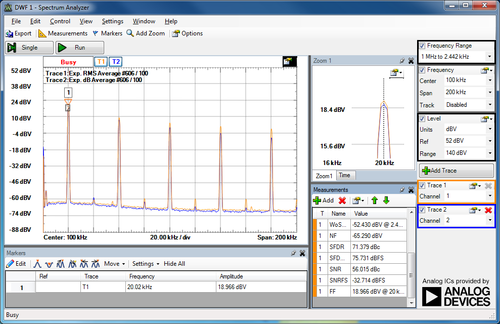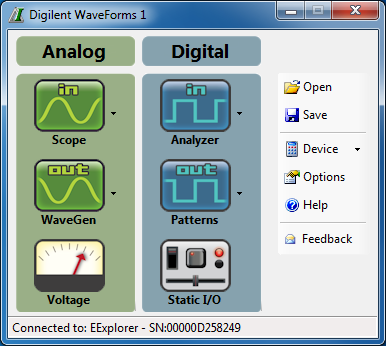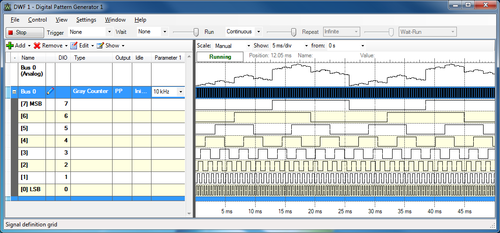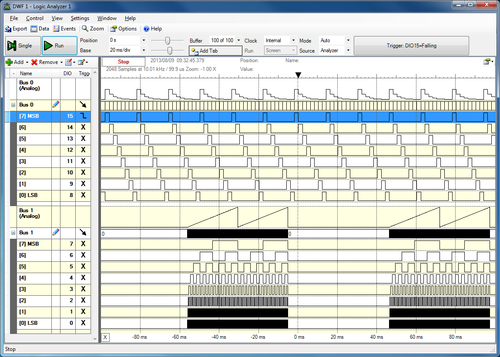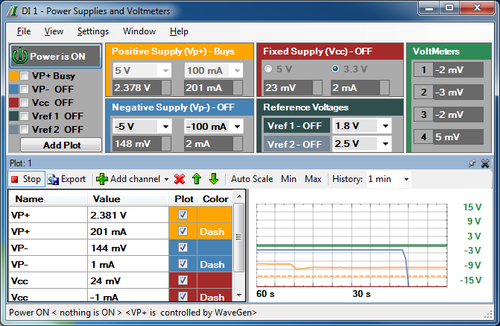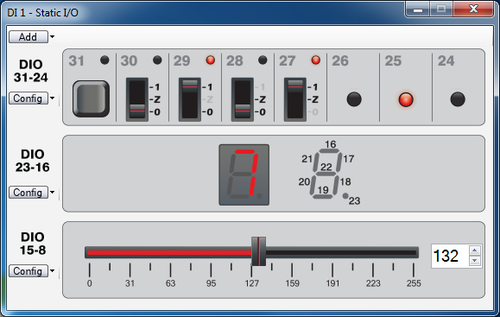WaveForms 2 (Legacy) Reference Manual
1. Getting Started with WaveForms
Install the WaveForms software, if you haven’t already. See Installer Details in the Help file for more information.
Connect your board to your PC using the USB connector and the supplied USB cable.
Start the WaveForms application from the Start Menu. Select Programs > Digilent > WaveForms > WaveForms.
The application starts and connects to your board.
The status bar of the WaveForms main window displays the device name and serial number as shown below.
1.1. Troubleshoot WaveForms
Only one application can be connected to only one board at a time. If you get the message “The selected device is being used by another application” check the taskbar and system tray for other WaveForms applications in use.
If the device configuration fails, check the power supply of your board.
If some instruments are not working as expected, try Load Default Configuration from that instrument’s window.
If the application is not working as expected, try Erase Configuration from the Settings menu.
If the application is still not working, close WaveForms and launch it in Safe Mode (from the Start menu, choose Programs > Digilent > WaveForms > Tools > WaveForms – Safe Mode). Launching WaveForms in Safe Mode will erase the application's last and default configurations. The last configuration is the one saved by the application when it is closed. The default configuration is the one set by the user.
1.2. Select an Instrument
The WaveForms main window (shown above) has buttons for each of the six instruments: Oscilloscope, Waveforms (the Arbitrary Waveform Generator), Voltage (the Power Supplies and Voltmeters instrument), Analyzer (the Logic Analyzer), Patterns (the Digital Signal Generator), and Static I/O (Static Digital Input/Output or SDIO).
Click on an instrument button to open the instrument’s main window (if the instrument is already open, it is brought to the front.) You can open additional instruments of the same type using the drop-down arrow as shown above. Note that only one Voltage and Static I/O instrument can be opened at a time.
An instrument button is disabled when the selected device or configuration does not support it. The Devices button opens the device manager window.
The Open and Save buttons let you load or save instrument workspaces.
Main window functions are also accessible from the hidden menu strip that is displayed by pressing the Alt key.
The instruments can also be accessed by right-clicking on the system tray menu as show below.
1.3 The Workspace
The workspace refers to any open instruments and their current state. The workspace can be loaded and saved with the Open and Save buttons on the main WaveForms window.
The workspace files are associated with WaveForms. When you open a workspace (double-click on a *.diwork file) and WaveForms is running, then the following window is opened.
2. Device Manager
The Device Manager lets you select the device and configuration to use with WaveForms.
To open Device Manager, from the main WaveForms window select the Device drop-down menu. Select Manager.
Filter: At the top-left corner is the filter for listing devices. The Find All filter shows the list of found devices and, if none is found, lists only the Demo and Sound Card devices.
Devices: Select the device you want to use. The Demo device lets you explore WaveForm’s capabilities without a physical device.
Configurations: Select the configuration you want to use for the selected device. The configurations have different device buffer-memory distributions for the instruments and other capabilities, like number of pins or channels.
Rename: The device's user name can be changed with the Rename button.
Calibrate: The Calibrate button opens the Calibration window.
3. Options Window
The Options window lets you select various display and configuration preferences.
To open the Options window, from the main WaveForms window select the Options button.
To change an option, select an item, then select the corresponding drop-down list item.
Multiple instances: Specifies whether multiple instances of the WaveForms application can run at the same time.
Remember device: Specifies whether to use the current device configuration or to use the default (first) device configuration at start-up or device selection.
Remember instruments: Specifies whether to restore the instruments that were open when the application was last closed.
Minimize to system tray: Specifies whether to remove WaveForms from the taskbar when the main window is minimized (it can still be accessed from system tray).
Main window topmost: Specifies whether the main window stays on top (in front) of other windows.
Sticky windows: Enables the sticky option, whereby windows stick to each other and to screen corners.
Hot drag: Enables hot dragging for docking windows. When the hot drag option is enabled, you can instantly move docking windows. When the option is disabled, you move the docking window to a new position by releasing the mouse button (or you can cancel the move by pressing the Escape key).
Configuration saving: Saves the configuration to a specific file type.
- No Packing: saves a single XML file containing settings and data
- No Compression: saves pack settings and data in one file
- Normal Compression: saves a packed ZIP file
Check for updates: Automatically checks for available updates and lets you download and install them.
Erase configuration: Specifies whether to erase the last configuration when you close an instrument.
Close: Closes the Options form and applies the settings.
4. Device Calibration
The Device Calibration window lets you calibrate (fine tune) a device’s analog components, like the read-voltage levels of the Oscilloscope or voltmeters and the output level of the Waveform Generator or adjustable power supplies.
The calibration process requires a precise voltmeter, ammeter, high-current resistors, and jumper wires.
Start the Device Calibration window from the Start menu > Programs > Digilent > WaveForms > Tools > WaveForms – User Calibration.
The following window opens.
Select the device you want to calibrate, then select the desired options.
Wizard: launches a wizard dialog and walks you through the calibration of each component.
Apply: saves the calibration changes made to the device.
Save: stores the current calibration parameters to a file.
Open: loads a saved calibration parameter file.
Reset: lets you change calibration parameters.
- Discard Changes: cancels any changes made after opening the Device Calibration window or pressing the Apply button.
- Load Factory: loads the default calibration parameters.
- Reset to Zero: resets the calibration parameters to zero.
Calibration tab: lets you double-click a listed device to start its calibration.
References tab: lets you review the measured calibration and reference values.
Parameters tab: lets you review the calibration parameters.
5. Docking Windows
The docking windows functionality gives you flexible organization of docking windows within the parent window.
The windows can be dragged by their top border. When dragging is started, small rectangles appear on the margins of the parent window. These margins indicate the drop regions. If you release the mouse in one of these regions, the child window is docked to the corresponding margin.
If you position a child window above another child window with same parent, a large dock indicator appears.
- Releasing the mouse on the sides docks the dragged window on the corresponding side of the other window.
- Releasing the mouse in the middle docks the child windows in tabular mode. When you drag above a drop region, a shadow shows where the window will be dropped.
- Releasing a window outside of drop regions makes the window float. Floating windows can be docked together to form a separate window.
- The push pin icon next to the close button locks the docked window, disabling the movement.
- A tabular window can be removed by dragging its tab from the bottom of the window, as shown below.
6. Triggers
The Electronics Explorer board has four trigger input pins. They are used by the Oscilloscope, Arbitrary Waveform Generator, Logic Analyzer, and Digital Pattern Generator instruments.
Any of these instruments can be triggered by any of the trigger signals coming from external pins or the other instruments.
The input instruments (Oscilloscope and Logic Analyzer) have a trigger detector based on their input channels. The trigger detector outputs a trigger signal which can be used by any instrument.
The output instruments (Arbitrary Waveform Generator and Digital Pattern Generator) output a trigger signal as long as they are running. The trigger event is the rising edge of the trigger signal.
The None trigger mode configuration in the instruments means that acquisition or generation doesn’t wait for a trigger, it starts immediately.
The Auto trigger mode for input instruments means that if the trigger condition doesn’t appear in approximately two seconds, acquisition is started automatically.
In multiple acquisition mode, when the instruments switch to Auto trigger, subsequent acquisitions are made without waiting for timeout as long as a trigger event does not occur and the configuration is not changed. When a new trigger event occurs or the configuration is changed, the current acquisition is finished and the next one waits for the trigger. It is also the best mode to use if you are looking at many signals and do not want to set the trigger each time.
7. Command Line Arguments
7.1. WaveForms Commands
The following are the command line arguments for the WaveForms application:
SCOPE launches the Oscilloscope instrument.
AWG launches Arbitrary Waveform Generator instrument.
PWR launches the Power Supplies and Voltmeters instrument.
LANA launches the Logic Analyzer instrument.
DSG launches the Digital Signal Generator instrument.
SIO launches the Static IO instrument.
*.diwork loads the workspace.
In order for these options to work, the path where the application is installed has to be selected in the command line.
7.2. Installer Commands
The Digilent installers, like DigilentInstrumentation.exe, have the following command line arguments:
/S (silent mode) installs or updates WaveForms without the installation wizard. If you use this option while WaveForms is running, installation might fail.
/CurrentUser or /AllUsers creates and installs shortcuts for the current user or for all users. This option works for fresh installs of WaveForms. Updates or additions use the option from the first installation. To change this option, WaveForms must be uninstalled than installed again.
/QuickLaunch creates Quick Launch shortcuts (does not work on Windows Vista and Windows 7).
/Update selects updateable components (by default, any uninstalled components are not selected).

